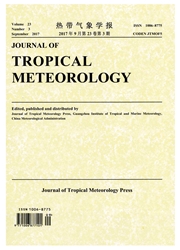

 中文摘要:
中文摘要:
With the Weather Research and Forecasting model(WRFV3.2.1), the application of spectrum nudging techniques in numerical simulation of the genesis and development of typhoon Longwang(2005) is evaluated in this work via four numerical experiments with different nudging techniques. It is found that, due to the ability to capture the large-scale fields and to keep the meso-to small-scale features derived from the model dynamics, the experiment with spectrum nudging technique can simulate the formation, intensification and motion of Longwang properly. The improvement on the numerical simulation of Longwang induced by the spectrum nudging depends on the nudging coefficients.A weak spectrum nudging does not make significant improvement on the simulation of Longwang. Although the experiment with four-dimensional data assimilation, i.e., FDDA, also derives the genesis and movement of Longwang appropriately, it fails to simulate the intensifying process of Longwang properly. The reason is that, as the large-scale features derived from the model are nudged to the observational data, the meso- to small-processes produced by the model dynamics important to the intensification of typhoon are nearly smoothed by FDDA.
 英文摘要:
英文摘要:
With the Weather Research and Forecasting model (WRFV3.2.1), the application of specmun nudging tech- niques in numerical simulation of the genesis and development of typhoon Longwang (2005) is evaluated in this work via four numerical experiments with different nudging techniques. It is found that, due to the ability to capture the large-scale fields and to keep the meso-to small-scale features derived from the model dynamics, the experiment with spectrum nudging technique can simulate the formation, intensification and motion of Longwang properly. The improve- ment on the numerical simulation of Longwang induced by the spectrum nudging depends on the nudging coefficients. A weak spectrum nudging does not make significant improvement on the simulation of Longwang. Although the experi- ment with four-dimensional data assimilation, i.e., FDDA, also derives the genesis and movement of Longwang appro- priately, it fails to simulate the intensifying process of Longwang properly. The reason is that, as the large-scale features derived from the model are nudged to the observational data, the meso- to small-processes produced by the model dy- namics important to the intensification of typhoon are nearly smoothed by FDDA.
 同期刊论文项目
同期刊论文项目
 同项目期刊论文
同项目期刊论文
 期刊信息
期刊信息
